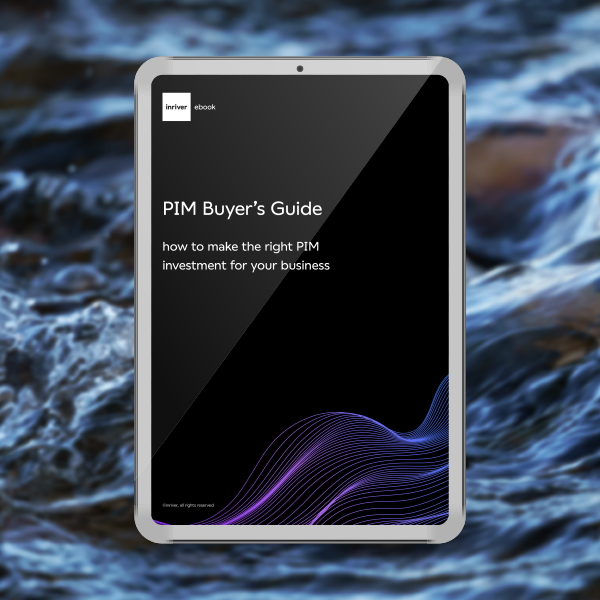SaaS PIM software: A 2025 guide
how to find the right PIM for you
In the market for PIM software this year? Make sure you choose the best SaaS solution that meets the evolving expectations places on your product data.
In the market for PIM software this year? Make sure you choose the best SaaS solution that meets the evolving expectations placed on your product data.
PIM software, which stands for Product Information Management, centralizes and organizes complex product data into one single source of truth for all internal and external endpoints.
However, not all PIMs are built equal. As more businesses shift operations to the cloud, SaaS (Software as a Service) PIM solutions are likewise seeing increased adoption—offering a scalable, flexible, cloud-based PIM platform to take control of expansive product catalogs.
But what is a SaaS PIM solution? And what does that mean for you? This 2025 guide explores the key features, benefits, and leading providers in the PIM SaaS landscape. Discover what to look for when evaluating solutions to meet your business’s needs today and tomorrow.
How does a SaaS PIM differ from other solutions?
When choosing a Product Information Management (PIM) system, understanding the differences between SaaS, on-premises, and hybrid solutions is crucial. SaaS PIM solutions, which are cloud-based and accessible from anywhere, offer key advantages in implementation speed, scalability, and cost-effectiveness compared to traditional on-premises systems.
SaaS PIM differs from on-premises and hybrid PIM solutions in a few areas:
- Deployment:
- SaaS PIM: Hosted in the cloud and accessed via a web browser, requiring no local installation.
- On-Premises PIM: Installed on individual company servers and devices, requiring dedicated IT infrastructure.
- Hybrid PIM: Combines cloud and on-premises elements, offering flexibility but requiring more complex management.
- Scalability:
- SaaS PIM: Easily scales with business growth, allowing companies to expand data storage, add users, and integrate new features without investing in additional IT resources.
- On-Premises PIM: Scaling requires purchasing more hardware, increasing IT costs and setup time.
- Hybrid PIM: Offers some cloud-based scalability but still relies on local infrastructure for core operations.
- Cost Structure:
- SaaS PIM: Uses a subscription-based model, allowing businesses to pay for only the features and storage they need, reducing upfront costs.
- On-Premises PIM: Requires significant upfront investment in hardware, software licenses, and IT staff for ongoing maintenance.
- Hybrid PIM: Costs vary depending on how much of the system is cloud-based versus on-premises.

Single- vs multi-tenant SaaS PIM
It’s important to distinguish between single- and multi-tenancy when dealing with a SaaS PIM solution. A single-tenant solution is built for, and used by, one singular organization—a single tenant. A multi-tenant solution, then, is built for many organizations to use.
While single-tenant solutions offer the most control, they’re also significantly more investment-intensive in both up-front and maintenance costs. Multi-tenant solutions share the maintenance cost with other tenants, making the cost much lower and maintenance much faster.
Combined with a SaaS framework, multi-tenant solutions allow for the freedom to scale as your business grows. With nearly zero downtime and always-updated software, multi-tenant solutions often serve as the ideal architecture for brands, manufacturers, and retailers.
Security and compliance
It used to be the case that organizations would favor on-premises solutions over SaaS solutions because of security. And while some enterprise organizations may still require some on-premises security, SaaS solutions now match or exceed the security and compliance capabilities of on-premises solutions.
Select advanced SaaS PIM platforms are SOC2 Type 2 certified, meaning they adhere to high standards for security, availability, processing integrity, confidentiality, and privacy. Integration with trusted ecosystems such as Microsoft Azure further establishes compliance with both international and industry-specific standards.
In addition, SaaS PIM solutions offer robust backup and recovery functionality, often at a lower cost than on-premise systems. Together, these factors show that the SaaS PIM platform is capable of handling security and compliance challenges over time, rather than just at a single point.

Benefits of SaaS PIM Software
It’s clear already that SaaS PIM software boasts flexibility and ease of use, which come into play throughout a PIM software’s lifecycle:
- Implementation: One of the key benefits of SaaS PIM platforms is their speed and ease of implementation, offering deployment in a matter of days instead of months to help brands, manufacturers, and retailers gain value sooner.
- Automatic updates: A SaaS model also streamlines and automates software updates, meaning businesses benefit from the latest features without needing manual updating, incurring additional costs, or suffering from server downtime.
- Global accessibility: The cloud-based nature of SaaS PIM ensures that it can be accessed globally, supporting remote collaboration and allowing for a geographically dispersed workforce that is fully in sync with the rest of the organization.
- Cost-effectiveness over time: For most mid-market and enterprise organizations, SaaS PIM solutions offer long-term savings by trading excessive infrastructure costs with a low monthly subscription cost. Since you only pay for what you need, costs scale linearly with use, meaning more predictable costs and fewer unforeseen maintenance expenses.
Key features to look for in 2025
Selecting the best SaaS PIM partner can help your business meet the growing demands of omnichannel commerce and regulations in 2025 and beyond.
Here are the key features to look for in 2025:
1. Fully extensible data models
Any business that plans to grow its catalogs or operations should consider a fully extensible data model as an essential requirement to provide the flexibility needed to manage an ever-evolving product catalog. Such agility is necessary to match the growing complexity of modern commerce operations.
New products, SKUs, attributes, and compliance with emerging regulations and market demands are just a handful of the factors that put a strain on data management systems. Impending regulatory changes like the European Union’s Digital Product Passport (DPP) are just one of the reasons why flexible data models will be invaluable for enterprises.
Fully extensible data models ensure your SaaS PIM solution can scale and evolve as your business does. This elasticity accommodates the continuous expansion of product lines and entry into new markets—all while managing an ever-growing volume of data—with ease.

2. AI, ML, and NLG integrations
The integration of AI and Machine Learning (ML) is another key feature that will define the capabilities of leading SaaS PIM systems through 2025 and beyond. Harnessing AI and ML through integration with leading engines like OpenAI will allow SaaS PIM systems to generate impactful insights, optimize decision-making, and automate repetitive tasks. Advancements in AI-driven Natural Language Generation (NLG) can also enhance product descriptions and content enrichment.
As AI continues to evolve, future SaaS PIM solutions will become even more intuitive, enabling businesses to automate product data workflows, improve decision-making, and drive sales growth—all while minimizing manual intervention. Investing in a PIM with AI and ML capabilities ensures that businesses stay ahead of the competition by managing their product data more efficiently and intelligently than ever before.
3. Multi-platform integration
An advanced PIM solution isn’t just another layer in your tech stack—it’s the center of it. That means leading SaaS PIM solutions are equipped to integrate seamlessly with many platforms.
Some key business systems that should integrate with SaaS PIM include:
- Enterprise Resource Planning (ERP): Synchronizing product data with ERP systems (e.g., SAP, NetSuite, Microsoft Dynamics) ensures accurate inventory, pricing, and supply chain data across the organization.
- Customer Relationship Management (CRM): Connecting PIM with CRMs (e.g., Salesforce, HubSpot) allows sales and marketing teams to leverage enriched product data for better customer interactions and personalized campaigns.
- Digital Asset Management (DAM): Integration with DAM platforms enables seamless management of product images, videos, and marketing collateral, ensuring that all assets are properly tagged and associated with the correct SKUs.
- E-commerce & Marketplaces: PIM solutions should integrate with major platforms such as Shopify, Magento, WooCommerce, Amazon, eBay, and Walmart to maintain consistent product data across all sales channels.
- Product Lifecycle Management (PLM): For manufacturers and brands, integrating PIM with PLM software ensures a smooth transition from product development to market launch, keeping all product attributes and specifications accurate.
Multi-platform integration makes sure that all the valuable data sitting in your current tools makes its way to your PIM—so that it can be enriched by your team and appreciated by your customers.
4. Advanced data governance tools
Brands, manufacturers, and retailers managing thousands (and, often, millions) of product data points know it takes a village to keep a handle on all that data. As the gatekeeper of your product data, an advanced SaaS PIM solution should have data governance procedures in place to make your product data accessible and functional for the teams that need to use it.
Advanced data governance tools play a crucial role in maintaining this integrity. Validation and standardization mechanisms automatically enforce formatting rules, naming conventions, and categorization guidelines to keep product data uniform.
Version control and audit trails allow businesses to track changes over time, providing full visibility into edits while enabling quick rollbacks if needed. Access controls ensure that the right stakeholders can update or modify product data while preventing unauthorized changes, which is particularly important for companies operating across multiple teams and regions.
5. Digital Shelf Analytics (DSA)
In today’s highly competitive e-commerce landscape, brands must ensure their product listings are complete, optimized, and converting customers across all online channels. Digital Shelf Analytics (DSA) plays a vital role in helping businesses monitor, analyze, and optimize their product performance across multiple digital touchpoints.

A SaaS PIM solution with built-in DSA capabilities provides real-time visibility into how products are displayed and performing on different e-commerce platforms and marketplaces. This data-driven approach allows brands to identify gaps, adjust product content, and increase sales conversions by ensuring that every digital shelf is accurate, engaging, and competitive.
Key Benefits of Digital Shelf Analytics in SaaS PIM:
- Real-Time Product Content Monitoring: Detects missing images, incomplete descriptions, or incorrect pricing across digital sales channels.
- Competitive Benchmarking: Compares product visibility, pricing, and content quality against competitors to ensure strong market positioning.
- Performance Insights & Conversion Optimization: Analyzes how product descriptions, images, and videos impact customer engagement and sales.
- Stock & Availability Tracking: Prevents lost sales by monitoring inventory levels across multiple marketplaces and retail partners.
- Customer Sentiment Analysis: Uses AI to analyze product reviews and ratings, identifying recurring issues or opportunities for improvement.
Despite its business-critical nature, many SaaS PIM providers have yet to integrate DSA natively into their platforms. Forward-thinking brands should prioritize SaaS PIM solutions that offer integrated DSA capabilities to gain a competitive edge.
6. Supplier onboarding
Streamlining onboarding for suppliers, co-manufacturers, and other partners is crucial for ensuring product data integrity from the start and meeting evolving regulator demands for transparent supply chain data. Without a structured onboarding process, errors, delays, and compliance issues can disrupt product launches and create inconsistencies across sales channels.
A SaaS PIM with supplier onboarding functionality simplifies this process by providing a centralized platform where suppliers can submit and update product information. Instead of relying on emails and spreadsheets, businesses can use a self-service portal that streamlines data collection, ensuring all required attributes are captured upfront. Automated validation checks flag missing or incorrect data before it goes live, reducing errors and keeping product listings accurate.
7. Automated translation
To facilitate rapid global expansion and reach more customers, prioritizing SaaS PIM platforms that offer automated multilingual translation will be crucial.
PIM software with extensible data models manages languages at an attribution level. This streamlines the localization phase when scaling into new regions and markets to connect you with new customers faster.
8. GDSN/GS1 compatibility
Standardization using GS1 like the Global Data Synchronization Network (GDSN) makes your product data more shareable. This widely accepted data format helps keep your product information compliant across channels and maintains consistency across integrated partners. For omnichannel and global strategies in 2025, this SaaS PIM feature is table stakes.
For brands operating in omnichannel commerce and global markets, GDSN compliance is essential for meeting retailer and marketplace requirements, ensuring that product information aligns with industry regulations, and streamlining the exchange of product data between manufacturers, suppliers, and distributors. As regulations evolve—particularly in industries like healthcare, food, and consumer goods—PIM solutions with GDSN compatibility provide businesses with a future-proof approach to maintaining data accuracy and regulatory compliance across all sales channels.
9. Data pool connectivity
In the same vein of data standardization, data pools are another means of standardizing your product data to align with partners or industry entities. SaaS PIM software with data pool connectivity gives you the ability to conform to a variety of data pools to help ensure your product information is consistent and reliable.

Top SaaS PIM Solutions in 2025
Multiple providers offer capable SaaS PIM functionality. However, subtle differences define solution leaders positioned to deliver the most ROI in the years ahead.
| Capabilities | ||||||||||
| PIM Vendor | Translation Automation | Supplier Onboarding | PDS | Brand Portals | AI & OpenAI | DSA | NLG | Fully Extensible Data Model | Data Pools | GDSN/GST |
| inriver | ✅ | ✅ | ✅ | ✅ | ✅ | ✅ | ✅ | ✅ | ✅ | ✅ |
| Akeneo | ✅ | ✅ | ✅ | ✅ | ✅ | ❌ | ✅ | ❌ | ✅ | ❌ |
| Pimberly | ✅ | ✅ | ✅ | ✅ | ✅ | ❌ | ✅ | ❌ | ❌ | ✅ |
| Sales Layer | ✅ | ✅ | ✅ | ✅ | ✅ | ❌ | ❌ | ❌ | ❌ | ✅ |
| Salsify | ✅ | ✅ | ✅ | ✅ | ✅ | ✅ | ❌ | ❌ | ✅ | ✅ |
| Stibo | ✅ | ✅ | ✅ | ❌ | ✅ | ❌ | ✅ | ❌ | ✅ | ✅ |
| Syndigo | ✅ | ✅ | ✅ | ✅ | ✅ | ✅ | ✅ | ❌ | ✅ | ✅ |
inriver
inriver offers a feature-rich SaaS PIM and is recognized as an industry leader in the PIM market by analysts at Gartner. The inriver platform provides the complete solution with integrated market-leading capabilities. This includes data onboarding, AI-powered content enrichment, API-based syndication, and digital shelf analytics.
inriver also leads the conversation surrounding sustainability and SKU-level traceability to enable compliance reporting. Notably, it is also the only SaaS PIM solution to offer a fully extensible data model—a key aspect in staying ahead of regulatory requirements.
Akeneo
The Akeneo PIM focuses on product data quality and governance through flexible modeling tools and structured workflow processes. The Akeneo solution offers syndication and AI-powered automation but falls short in digital shelf analytics and the flexibility of its data model. Akeneo is particularly known for its open-source PIM software.
This solution also offers features similar to inriver, except for digital shelf analytics (DSA) and extensibility. It is particularly known for its flexible open-source model.
Pimberly
As a newer solution, Pimberly Cloud PIM features an intuitive interface and robust core PIM functions. However, there are gaps around certain leading-edge functions that may limit long-term scalability for enterprise brands, such as its lack of:
- Data pools
- Extensibility
- DSA
SalesLayer
Purpose-built for B2B selling, SalesLayer couples a rich attribute library with sales materials fulfillment integration.
SalesLayer provides a strong foundation including automated translation and supplier onboarding. However, it lacks next-gen technologies like data pool connectivity, DSA, NLG, and an extensible data model.
Salsify
Salsify differentiates itself in a crowded SaaS PIM market by emphasizing digital shelf analytics and campaign measurement.
It offers a comprehensive range of capabilities, but some features around data modeling, NLG, and long-tail integrations are less mature than its competitors.
Stibo
Known for their on-premise PIM solutions, Stibo Systems now offers expanding SaaS-based options and pre-built connectors thanks to advanced validation and data pools inherited from their legacy DAM platform.
While viable, Stibo does not offer brand portals or DSA, which can be critical features for ensuring brand consistency across multiple channels.
Syndigo
Syndigo is a leader when it comes to market and buyer intelligence. As a newer SaaS PIM solution, Syndigo incorporates next-gen capabilities such as:
- DSA
- NLG
- AI integrations
While showing strength in data syndication and enrichment, Syndigo software lacks an extensible data model, with other core PIM capabilities still in the process of maturing.
Future Trends in SaaS PIM
As the digital landscape accelerates toward e-commerce and global expansion, SaaS PIM solutions are evolving to meet new challenges and opportunities. Here are the five trends set to shape SaaS PIM in 2025:
- AI influence: AI will continue to revolutionize PIM, especially in content creation and enrichment. Advanced PIM solutions will actively integrate AI to enable the creation of rich, compelling, and localized product content efficiently.
- Digital Product Passports (DPPs): With regulations like DPPs becoming more prevalent, there’s an increasing need for PIM solutions that can manage comprehensive and accessible product information, ensuring compliance and transparency.
- Product origin stories: Consumers are increasingly interested in the origins and sustainability of products. PIM solutions will play a key role in capturing, standardizing, and distributing this information in the form of authentic origin stories.
- Digital Shelf Analytics (DSA): Understanding online product performance will become an essential factor in advanced SaaS PIM solutions. Integrating DSA provides agility in delivering compelling product experiences across digital marketplaces.
- Cloud marketplaces for PIM procurement: The availability of PIM solutions on cloud marketplaces like Microsoft Azure, Amazon Web Services, Google Cloud, and Salesforce will simplify the procurement process, making it easier for businesses to adopt PIM solutions.
To keep up with these trends, a comprehensive PIM solution that supports every step of the circular product journey while evolving at the cutting edge of tomorrow’s innovations has never been more essential.
inriver: The future of SaaS PIM solutions
The right SaaS PIM for you in 2025 and beyond should offer more than simple data aggregation. It needs to extend further to provide the key technologies and solutions that can onboard raw, unstructured supply chain data, transform it into rich and compelling product information, and ensure this information remains correct, complete, and compliant across every internal and external channel. Only then can you be sure you are maximizing the value of your product data.
That’s why so many forward-thinking brands, manufacturers, and retailers are choosing inriver as their SaaS PIM provider. The inriver PIM is the only SaaS solution that combines DSA with fully extensible data modeling and cutting-edge AI integrations into a comprehensive multi-tenant SaaS platform. By using robust data intelligence to unify commerce, deliver compelling product experiences, and elevate the buyer journey, the inriver platform can take your entire operation to the next level.
want to see the inriver PIM in action?
Schedule a personalized, guided demo with an inriver expert today to see how the inriver PIM can get more value from your product information.
you may also like…
frequently asked questions
how does a SaaS PIM support product data accuracy and governance?
A SaaS PIM solution ensures accurate and reliable product information by centralizing data from multiple sources into a single, structured system. Built-in validation rules, version control, and data enrichment tools help maintain high data quality while reducing inconsistencies. Additionally, advanced data governance capabilities allow businesses to control access, enforce data standards, and manage approvals efficiently—ensuring that only the most up-to-date and compliant information is syndicated across channels.
what are the challenges of implementing a PIM system, and how can they be addressed?
While adopting a PIM system brings many advantages, businesses may face challenges such as integration complexities, data migration hurdles, and user adoption issues. To overcome these, it’s essential to choose a PIM solution with centralized architecture, robust API connectivity, and support for seamless implementation. Additionally, ensuring adequate training and internal buy-in can significantly ease the transition and maximize the benefits of the system.
how does a cloud-based PIM compare to an on-premises PIM in terms of scalability?
A cloud-based PIM platform offers greater scalability than traditional on-premises solutions. With SaaS solutions, businesses can scale storage, user access, and features on demand without the need for additional infrastructure investment. This flexibility enables brands to expand product catalogs, enter new markets, and adapt to evolving industry requirements—all while keeping costs predictable and manageable.
why is multi-platform integration important for a SaaS PIM?
A SaaS PIM is most effective when it seamlessly integrates with existing business tools, such as ERP, CRM, DAM, and e-commerce platforms. Multi-platform integration ensures that product information flows effortlessly across all systems, reducing manual data entry, preventing errors, and enabling a more efficient product lifecycle management process. Choosing a PIM solution with pre-built connectors and open APIs enhances operational agility and data consistency.
how can a PIM help businesses grow in competitive e-commerce environments?
A robust SaaS PIM solution provides businesses with the tools needed to grow and compete in dynamic markets. By optimizing product data for various digital channels, ensuring accurate and engaging content, and streamlining syndication processes, a PIM platform helps brands expand their reach and boost conversions. Additionally, SaaS PIM solutions with built-in analytics and automation empower businesses to make data-driven decisions that drive revenue and customer satisfaction.
